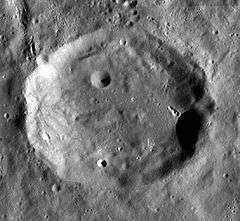Raimond (crater)
Raimond is a lunar impact crater that lies on the Moon's far side. Less than one crater diameter to the northeast is Bredikhin, and farther to the west is McMath. To the north-northwest lies the prominent crater Jackson, which is surrounded by a large ray system. Raimond is almost completely covered by this ray material, and a pair of prominent rays cross the northeastern and southwestern portions of the crater.[1]
 LRO WAC mosaic | |
| Coordinates | 14.6°N 159.3°W |
|---|---|
| Diameter | 68.37 km |
| Depth | unknown |
| Colongitude | 160° at sunrise |
| Eponym | Jean J. Raimond, Jr. |

This crater is slightly elongated along the east–west axis, giving is a slightly oblong appearance. The rim edge is moderately worn, although no significant impacts lie across the edge. The interior is relatively featureless, with only a few small craterlets and the ray material from Jackson crater to mark the surface.
Raimond lies near the center of the Dirichlet-Jackson Basin.
Satellite craters
By convention these features are identified on lunar maps by placing the letter on the side of the crater midpoint that is closest to Raimond.
| Feature | Latitude | Longitude | Diameter | Ref |
|---|---|---|---|---|
| Raimond K | 13.3° N | 158.2° W | 32.88 km | WGPSN |
| Raimond Q | 11.6° N | 161.7° W | 27.5 km | WGPSN |
See also
- 1450 Raimonda, asteroid
References
- "Raimond (crater)". Gazetteer of Planetary Nomenclature. USGS Astrogeology Research Program.
- Andersson, L. E.; Whitaker, E. A. (1982). NASA Catalogue of Lunar Nomenclature. NASA RP-1097.CS1 maint: ref=harv (link)
- Blue, Jennifer (July 25, 2007). "Gazetteer of Planetary Nomenclature". USGS. Retrieved 2007-08-05.CS1 maint: ref=harv (link)
- Bussey, B.; Spudis, P. (2004). The Clementine Atlas of the Moon. New York: Cambridge University Press. ISBN 978-0-521-81528-4.CS1 maint: ref=harv (link)
- Cocks, Elijah E.; Cocks, Josiah C. (1995). Who's Who on the Moon: A Biographical Dictionary of Lunar Nomenclature. Tudor Publishers. ISBN 978-0-936389-27-1.CS1 maint: ref=harv (link)
- McDowell, Jonathan (July 15, 2007). "Lunar Nomenclature". Jonathan's Space Report. Retrieved 2007-10-24.CS1 maint: ref=harv (link)
- Menzel, D. H.; Minnaert, M.; Levin, B.; Dollfus, A.; Bell, B. (1971). "Report on Lunar Nomenclature by the Working Group of Commission 17 of the IAU". Space Science Reviews. 12 (2): 136–186. Bibcode:1971SSRv...12..136M. doi:10.1007/BF00171763.CS1 maint: ref=harv (link)
- Moore, Patrick (2001). On the Moon. Sterling Publishing Co. ISBN 978-0-304-35469-6.CS1 maint: ref=harv (link)
- Price, Fred W. (1988). The Moon Observer's Handbook. Cambridge University Press. ISBN 978-0-521-33500-3.CS1 maint: ref=harv (link)
- Rükl, Antonín (1990). Atlas of the Moon. Kalmbach Books. ISBN 978-0-913135-17-4.CS1 maint: ref=harv (link)
- Webb, Rev. T. W. (1962). Celestial Objects for Common Telescopes (6th revised ed.). Dover. ISBN 978-0-486-20917-3.CS1 maint: ref=harv (link)
- Whitaker, Ewen A. (1999). Mapping and Naming the Moon. Cambridge University Press. ISBN 978-0-521-62248-6.CS1 maint: ref=harv (link)
- Wlasuk, Peter T. (2000). Observing the Moon. Springer. ISBN 978-1-85233-193-1.CS1 maint: ref=harv (link)